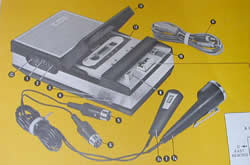
Early Philips “Carry Corder”
The cassette actually predated the 8-track by about a year. It was originally promoted as an inexpensive music recorder/player for children, or simply a general purpose sound recorder, but not as hi-fi equipment like the 8-track. The small, two-reel cartridge system was introduced by Phillips in Europe and Norelco in the U.S. in 1964 (in Europe a little earlier), and was based on, but intended for a different market than, a similar small cartridge system that Phillips introduced for office dictation purposes. The first “Carry-Corder” battery operated cassette recorder/player made low quality recordings in mono only, but within a few years a stereo version was available, as were several home models that aspired to hi-fi status. When the cassette proved to be a popular medium for music, more companies began to manufacture the player/recorders with the encouragement of Philips.
Sound quality gradually improved over the life of the cassette system. One of the first cassette modifications aimed at overcoming its sonic deficiencies was a “hiss” reduction circuit invented by engineer Ray Dolby, formerly a key employee of Ampex Corporation. His Dolby system had first appeared in pro and reel-to-reel recorders, but was adapted for cassettes in 1968-9. The introduction of better quality, home cassette decks by Ampex and others in the late 1960s and early 1970s elevated the reputation of the format and helped make it acceptable to the hi-fi crowd.
Meanwhile it had become the technology of choice for those interested in making copies of records for use in battery operated portables or in-car tape players. In terms of pre-recorded cassettes, sales overtook 8-tracks in the mid-1970s, then overtook LPs in the early 1980s. For a time in the 1980s, the cassette was the most popular home music format for both home recording and pre-recorded listening applications. Improved versions of Dolby appeared tailored for tape, and the venerable gamma-ferric oxide tape formulation, used since the 1940s for reel-to-reel tape, was superseded with mixtures that contained iron oxide mixed with or replaced by chromium dioxide or metal particles. The 90-minute tape became the best-selling blank tape, reflecting the fact that two full albums could usually be recorded on a single 90-minute cassette. The format spawned an ever-wider variety of portable and home recorders and players. In addition to the small battery operated portables available since the beginning, larger, more powerful “boomboxes” began to be popular in the late 1970s. These versatile devices were, for many people throughout the world, the primary form of home or personal audio technology for many years. If the trend in boomboxes was toward bulkier and bulkier devices, the cassette spawned a second movement toward “personal audio.” Following on the heels of its successful line of home VCRs, Sony Corporation in 1977-8 introduced its Walkman line of battery operated radios and tape players. Copycats jumped into the market the next year, and soon there was a bewildering variety of personal audio products. The CD-Walkman was available by mid-decade, and the trend persists today with small MP3 players.